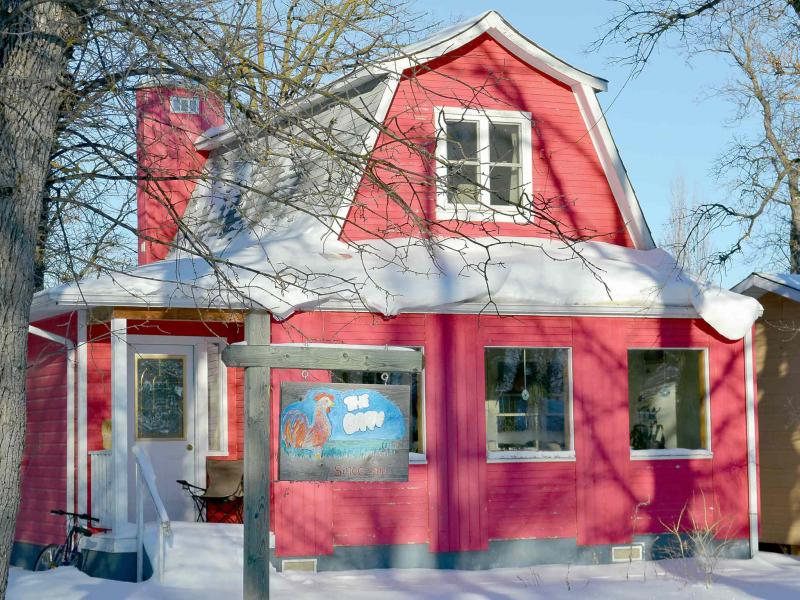

22Originally constructed as a cottage known as The Barn in 1910, the dilapidated building was purchased by Watson in 1999 because it "had a good feel to it. I felt it needed to be saved."
A little daunted by the task of renovating a century-old dwelling that many people would have bulldozed, Watson undertook the task with enthusiasm and a "little cursing at times."
He started by gutting the interior, removing rotted flooring and tearing sheets of wallboard with a fake wood figure from the two-inch by four-inch studs.
Under the phony wall board, he uncovered cedar boards 10-inches wide by a half-inch thick that had been the original interior wall.
"Why anyone would cover such gorgeous wood is beyond me," said Watson, who carefully removed the boards and later used them to line his closets.
Inside the walls, he found a disgusting mixture of sawdust, rodent droppings and a few squirrel skeletons.
"Cleaning up that mess was the least pleasant part of the job," said Watson, who also tore off a wraparound porch that was sinking into the ground, salvaging any sound lumber to build a garage.
Instead of cutting down several large maple trees that prevented him from adding on a kitchen and dining area, Watson decided to move the gutted building several feet to the east, leaving the trees intact, yet providing sufficient room for his additions.
"To me, trees are sacred; one of the most beautiful natural features of the Winnipeg Beach area," he said.
His choice to move the building caused a few headaches, however.
The structure twisted during the procedure and, as a result, was out-of-square when it was placed on the new concrete footing.
"By the time I noticed the mistake, it was too late to correct. I had to cut some odd angles in the finishing material when I was completing the interior," he recalled.
His decision to recycle hundreds of board feet of T&G maple, salvaged from the sergeant's mess in the former Gimli airbase, resulted in the most time-consuming part of the reno.
"The price was very reasonable, but I kind of under anticipated the sweat equity involved," he said.
Not only did thousands of old nails need to be removed from the tongues, but the boards were stained with wine and there were holes where plywood had been nailed overtop of them.
"When I was laying the floor in my house, I had to eliminate pieces that were too badly damaged," said Watson, adding he used a small, hand-held belt sander with number-60 paper for the initial sanding-- that's what I call true grit.
He said the entire job took the better part of a winter, but it was "a joy to see the wood come clean and the gorgeous figure revealed."
The recycled flooring was used in the living room and the upstairs hallway and bedroom.
Because the house has a barn-style gambrel roof, the bedroom has charming slanted ceilings and sufficient room for two beds, as well as a replica casement window overlooking the well-treed front yard.
At the opposite end of the second-floor hallway, Watson added an extra bathroom; a door leads to an outdoor deck he also built: "An enjoyable place to sleep at night or sit among the leaves with the birds in summer."
A spiral staircase that Watson created from scrap steel and recycled wood is a striking feature of the house, providing easy access to the first and second floors.
"I was a welder/iron worker for 30 years, so I built the metal frame fairly quickly. But when it came to the bent wood railing and triangular treads, things went more slowly," he said.
In order to get the correct height and right number of steps, Watson converted an Imperial formula based on 1/12 to a decimal formula based on 1/10.
"The decimal system greatly simplified the calculations," he said.
The house was insulated to the R-2000 standard; the walls were covered with drywall and the windows were replaced with triple-pane glass.
The exterior was painted strawberry red with white trim by a group of local artists who felt the colours would enhance the building's iconic status as The Barn.
In the living room, Watson added wainscoting reminiscent of the era when the cottage was constructed.
A large kitchen was built onto the west side of the house, including a tiled floor, crackle-painted cabinets with an antique look, and countertops built of red oak flooring.
The dining area has fir T&G flooring recycled from the original cottage, as well as a large bay window that provides lots of daylight.
Watson also added a year-round front porch with large, double-glazed windows that he framed in solid cedar at accost of $160 per window.
French doors, dating back to 1910, lead into the sunny, south-facing porch that Watson said "is as good as a trip to Mexico."
"I wear a T-shirt, sit in a comfortable chair, drink cold beers and watch people pass by in the frigid winter weather."
As the front of the house was left intact after the old porch was removed, he said he left several original casement windows in place as a sign of respect to the old building and its makers.
"The French doors and antique windows are what I love most about The Barn," said Watson's partner, Helma Rogge Rehders, a respected fine artist and recent first-place winner of a Winnipeg Free Press poetry contest.
Rehders and Watson both attended the University of Manitoba's School of Fine Art, but didn't meet until later in life.
In 1996, Rehders purchased a house in Winnipeg Beach that required extensive renovations, a job that Watson, with a little push from his partner, felt capable of undertaking himself.
"If you're good at one trade, it's easier to learn another," said Watson in retrospect.
He completed the reno in a few years, including a separate art studio for Rehders.
"We both worked at other jobs to supplement our incomes during that period," she added. As the small home began to fill up with art work and freshly stretched canvases, it became apparent that "Jim (Watson) required a man cave of his own," said Rehders.
As fate would dictate, The Barn, a building Watson had coveted for years, went up for sale; he took possession in 1999, with Rehders as a financial partner.
"Without Helma, I don't know that I would have had the fortitude or enthusiasm to see these two renovations to completion," said Watson, adding his partner has changed his life for the better in many ways and at many times.
For her part, Regehrs' likes to quote Ralph Waldo Emerson: "Nothing great was ever achieved without enthusiasm."
And breathing new life into old buildings requires plenty of that.



